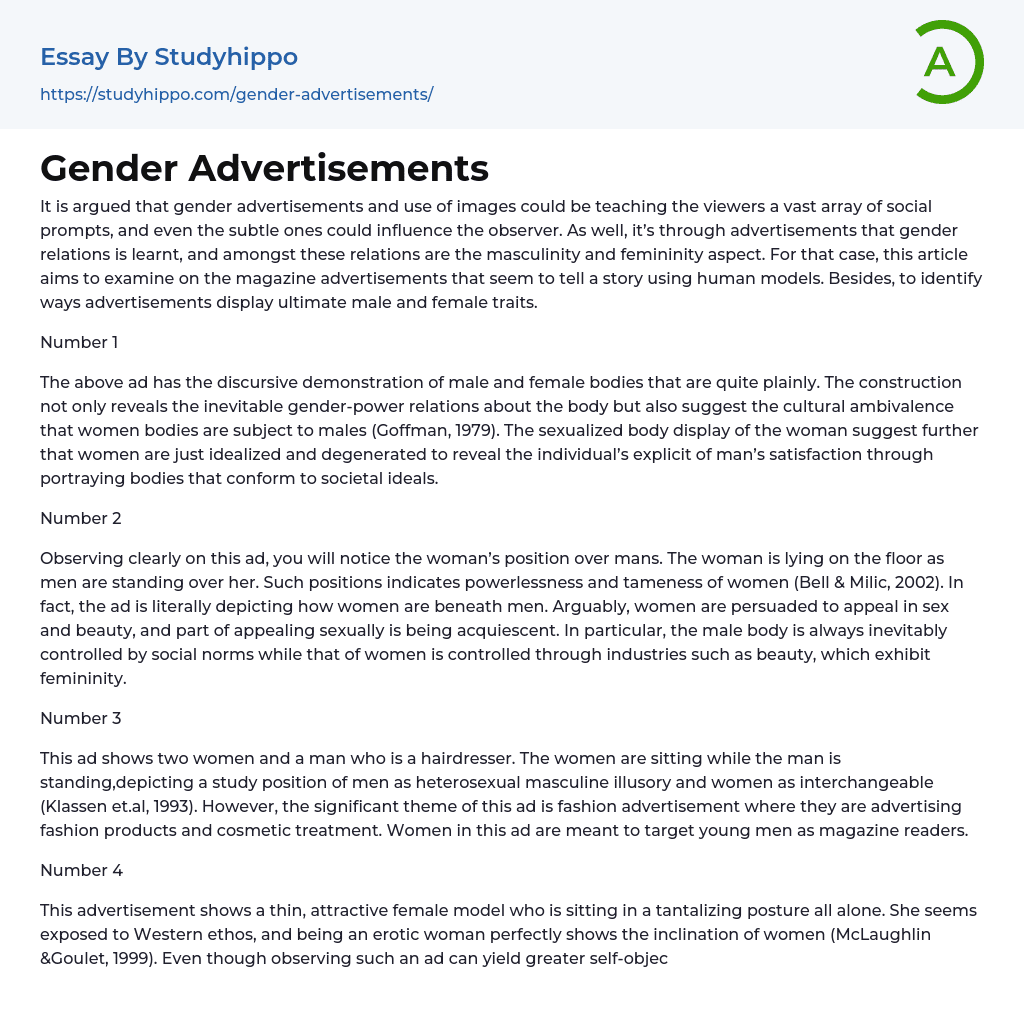Magazine advertisements employing human models convey a narrative that can influence viewers by imparting diverse social prompts, including subtle ones. These ads play a crucial role in shaping our perception of gender relations and the ideas surrounding masculinity and femininity.
This text also aims to analyze how advertisements depict traditional stereotypes associated with masculinity and femininity. The above-mentioned advertisement prominently features both male and female bodies, directly highlighting the power dynamics connected to gender and physical appearance. Additionally, it suggests the societal uncertainty surrounding women's bodies, which are often subjected to scrutiny by men (Goffman, 1979). Moreover, the sexualized portrayal of the woman further reinforces the objectification of women and their reduction to fulfilling men's desires while conforming to societal ideals.
Furthermore, upon closer examination of this advertisement, it becomes eviden
...t that the woman is depicted in a subordinate position beneath the men. As they stand over her, she lies on the floor.
The text suggests that the ad depicts women as powerless and submissive (Bell & Milic, 2002). It explicitly shows women being beneath men. One can argue that women are encouraged to focus on their sexual appeal and beauty, which involves being submissive. Notably, societal norms control the male body, while industries like beauty dictate femininity for women.
Number 3
This advertisement shows two seated women and a standing male hairdresser, implying that men are portrayed as heterosexual masculine illusions while women are seen as interchangeable (Klassen et.al, 1993).
However, the main focus of this advertisement is fashion and cosmetic treatment. It aims to target young men who read magazines.
Number 4
This ad features a thin and attractive female model sitting in a provocative pose. She embodies Western
values and represents an erotic woman, highlighting the importance of physical appearance for women (McLaughlin & Goulet, 1999). While viewing such an ad may lead to self-doubt, it also encourages women to reflect on their physical appearance.
References
- Bell, P., & Milic, M. (2002). Goffman’s Gender Advertisements revisited: combining content analysis with semiotic analysis. Visual communication, 1(2), 203-222.
- Goffman, E. (1979). Gender advertisements.
- Klassen, M. L., Jasper, C.
R., & Schwartz, A. M. (1993). Men and women: Images of their relationships in magazine advertisements. Journal of Advertising Research, 33(2), 30-40.
McLaughlin, T. L., & Goulet, N. (1999). Gender advertisements in magazines aimed at African Americans: A comparison to their occurrence in magazines aimed at Caucasians.
Sex Roles, 40(1-2), 61-71.
- Social Construction of Gender essays
- Male essays
- Same-Sex Marriage essays
- Masturbation essays
- 12 Angry Men essays
- A beautiful mind essays
- A Separation essays
- Alfred Hitchcock essays
- American Beauty essays
- American Films essays
- Animation essays
- Avatar essays
- Blade Runner essays
- Bollywood essays
- Bond essays
- Bridge essays
- Cinema Of The United States essays
- Comedies essays
- David essays
- Dead Poets Society essays
- Do The Right Thing essays
- Documentary essays
- English-Language Films essays
- Erin Brockovich essays
- Film Analysis essays
- Film Editing essays
- Film Noir essays
- Film Techniques essays
- Finding Forrester essays
- Forrest Gump essays
- Gattaca essays
- Gladiator essays
- Glory essays
- Good Will Hunting essays
- Hamilton essays
- Hollywood essays
- Horror essays
- Jaws essays
- King kong essays
- Like Water For Chocolate essays
- Looking For Alibrandi essays
- Martin Scorsese essays
- Melodrama essays
- Monster essays
- Moulin rouge essays
- Movie Analysis essays
- Movie Review essays
- On The Waterfront essays
- One Flew Over The Cuckoo'S Nest essays
- Our day out essays




